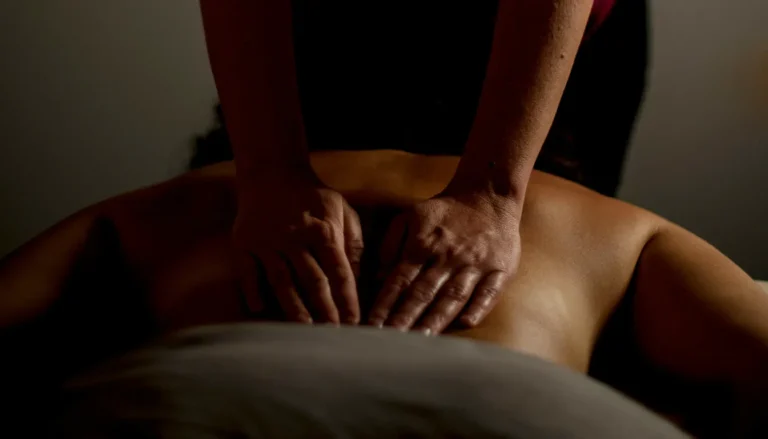Plain answer: Massage can lower stress levels and support sustainable weight plans when used alongside smart nutrition, activity and sleep — not as a lone treatment but as a supportive way to stay consistent.
Many people see the biggest gains indirectly. Lower cortisol and higher serotonin often improve sleep and mood, which makes meal planning, gym visits and recovery easier.
Better circulation and lymphatic flow reduce post-exercise soreness, swelling and fluid retention. This makes daily movement more doable and helps maintain a steady routine.
We outline how therapy works on hormones, sleep quality and blood flow, and which session types suit different needs. For practical guidance, see a useful guide on choosing the right approach at selecting the ideal massage.
Key Takeaways
- Supportive role: Best used with balanced nutrition, regular activity and good sleep.
- Indirect effects matter most — better mood and recovery aid routine adherence.
- Expect wellness gains rather than instant change on the scales.
- Therapy influences hormones, circulation and lymph flow for faster recovery.
- Pick style and length to match goals — Swedish for relaxation, sports for recovery.
Quick answer: how massage fits into stress relief and weight management today
In short, regular sessions can nudge hormones and circulation in ways that make healthy habits easier to follow.
Clinicians note therapy often lowers perceived tension while improving sleep quality. Advanced Kinetics report falls in cortisol with rises in serotonin and dopamine after repeated sessions. Melissa MacDuff highlights endorphin release and vasodilation that promote better blood flow for tissues.
It will not burn fat directly, but better sleep and readiness to train make it simpler to keep energy up and stay consistent with plans to lose weight. Recovery feels smoother; sore spots ease and range of movement improves, which helps performance at the gym or on runs.
“Consistency beats one-off treatments—regular sessions create the conditions for better sleep, calmer days and quicker recovery.”
- Lower cortisol: steadier stress levels and improved mood.
- Improved circulation: better delivery of oxygen and nutrients to working tissue.
- Recovery gains: reduced muscle tension and fewer niggles between workouts.
| Benefit | Short-term effect | Best for | How often |
|---|---|---|---|
| Hormone balance | Lower cortisol, higher serotonin | Sleep quality and mood | Weekly or fortnightly |
| Circulation & flow | Vasodilation and better blood delivery | Recovery after workouts | Every 1–3 weeks depending on activity |
| Muscle release | Less tension, improved range | Performance and injury prevention | Targeted sessions around training |
How massage may influence stress, sleep, circulation and recovery
Regular soft-tissue work nudges hormone patterns and circulation in ways that support calmer days and steadier recovery.
Lowering stress hormones and easing cortisol-related effects
Advanced Kinetics report falls in cortisol with rises in serotonin and dopamine after massage. Lower cortisol levels create a calmer base for appetite control and may limit central fat risk over time.
Improving sleep quality to support appetite, hormones and recovery
By easing muscle tension and physiological arousal, sessions often boost sleep quality. Better sleep helps regulate ghrelin and leptin, which steadies appetite and supports metabolic health.
Boosting blood circulation and lymphatic flow
Techniques that prompt vasodilation improve circulation and lymph flow. This aids nutrient delivery to tissue and eases swelling after intense training or long desk periods.
Supporting exercise recovery, performance and reduced fatigue
- Improved recovery means less residual fatigue and quicker return to training.
- Gentle soft-tissue work reduces protective muscle guarding, increasing range of movement.
- Over weeks these small effects compound, helping adherence to plans for weight and performance goals.
“Consistency beats one-off treatments—regular sessions create the conditions for better sleep, calmer days and quicker recovery.”
Choosing the right massage therapy for your goal
Different approaches suit different aims; pick a style that fits how you move and where you feel tension.
From Swedish to neuromuscular, sports, prenatal, cupping and trigger point
Swedish sessions focus on calm and relaxation, a good first step when high tension affects sleep and daily routine.
Neuromuscular Therapy targets the brain–muscle link for chronic pain or movement issues, as Melissa MacDuff explains.
Sports work helps stiffness and flexibility after training. Trigger point therapy aims at referral pain, while cupping promotes circulation.
Advanced Kinetics also offer lymphatic drainage for fluid balance and post-exercise swelling.
Picking a session length: 30, 60 or 90 minutes for targeted needs
Choose 30 minutes for a focused area such as neck or shoulders.
Pick 60 minutes for a full-body session with a few focus points.
Book 90 minutes when multiple regions or long-standing complaints need attention.
Working with your therapist: assessment, communication and personalisation
A good therapist will assess gait, posture and daily movement patterns to personalise pressure and focus.
Tell your practitioner where you feel pain and what “better” looks like. Clear feedback improves quality of the outcome.
If tension is very high, start with relaxation-first work (for example Swedish with aromatherapy or heat) before deeper muscle-focused sessions.
- Match type to aim: relaxation, repair or circulation.
- Be specific: name pain points and preferred pressure.
- Plan cadence: repeat sessions for cumulative recovery gains.
| Type | Best for | Typical length | Primary aim |
|---|---|---|---|
| Swedish | High tension, sleep quality | 60 min | Relaxation and nervous-system calm |
| Neuromuscular | Chronic pain, movement issues | 60–90 min | Brain–muscle rebalancing |
| Sports / Trigger point | Stiffness, referral pain | 30–60 min | Targeted muscle release and function |
| Cupping / Lymphatic | Circulation, fluid retention | 30–60 min | Improve flow and recovery |
| Prenatal | Comfort in pregnancy | 60 min | Safety, hip and back relief |
Does massages help reduce stress and weight loss: a practical how-to plan
A practical plan combines regular bookings with smart timing around training and sleep habits.
Set a realistic booking cadence and be consistent
Commit to a cadence you can maintain. Fortnightly is a friendly starting point for most people. Move to weekly during intense training blocks or busy periods, then taper as life calms.
Time your massage around workouts for better recovery
Place lighter sessions 24–48 hours after hard exercise to support recovery. Use gentle tune-ups before events to improve readiness without overloading the body.
Pair with sleep routines to stabilise stress levels
Turn appointments into sleep wins by dimming lights, sticking to a bedtime and avoiding late caffeine. Improved sleep helps cortisol settle and boosts overall quality of rest.
Support results with hydration and balanced nutrition
Nourish recovery with protein, colourful plants and fluids around training. Therapy won’t replace nutrients, but it can make meal prep and adherence easier.
Track changes in stress, sleep and training performance
Monitor resting heart rate, mood, soreness and session performance. Use this simple feedback to adjust bookings, training load or treatment focus.
| Action | When | Why | Tip |
|---|---|---|---|
| Cadence | Fortnightly → weekly as needed | Builds consistent benefits | Book ahead to keep routine |
| Workout timing | 24–48 hrs post hard session | Supports muscle recovery | Choose lighter pressure after heavy days |
| Sleep pairing | Evening wind-down | Improves sleep quality | Reduce screens and caffeine late |
| Nutrition & tracking | Daily around training | Supports metabolism and progress | Record simple metrics weekly |
“Consistency creates the conditions for better sleep, calmer days and smoother recovery.”
What to expect, common misconceptions and safety notes in the UK
Before booking, know what realistic benefits look like and where claims outpace the evidence. Therapists in the UK treat this work as a supportive tool alongside exercise, balanced nutrition and good sleep.
Massage is a support tool—not a standalone weight loss treatment
Expect supportive benefits: sessions often ease pain, calm the nervous system and make training easier to keep up. They are not a medical treatment for obesity or a shortcut to weight loss.
Be wary of claims about “toxin removal” or spot fat reduction. Focus on real gains: less soreness, steadier mood and improved readiness to exercise.
Who may need adaptations or medical advice before treatment
Tell your therapist about cardiovascular issues, clotting disorders, recent surgery, uncontrolled diabetes, pregnancy or cancer therapy. Practitioners can adapt the session—shorter time or gentler techniques—where needed.
- If you take blood thinners or have osteoporosis, request lighter pressure and specific methods.
- Start with Swedish or gentle therapy when arousal is high; progress depth across visits.
- Those new to exercise can use sessions to ease initial soreness and build momentum safely.
| Issue | Adaptation | Why |
|---|---|---|
| Blood thinners | Gentle techniques only | Reduce bruising and bleeding risk |
| Recent surgery | Avoid area; use light mobilisation | Allow healing, prevent harm |
| Pregnancy | Special positioning and trained therapist | Comfort and safety for mother and baby |
If a session feels too intense, speak up. Good services should feel productive, not punishing. Combine therapy with gradual exercise, balanced meals and adequate sleep for the most reliable changes in mood, energy and metabolism.
Conclusion
Conclusion
Consistent therapy often creates practical gains: calmer evenings, clearer appetite cues and smoother workouts.
Massage and massage therapy improve sleep, circulation and recovery in ways that make training and meal plans easier to keep. By easing muscle tension and calming the nervous system, sessions support better movement, fewer flare-ups of pain and less fatigue.
Choose the right type and technique for your aim — Swedish for relaxation, sports or neuromuscular for targeted repair, cupping or lymphatic-style work for improved flow. Pair treatments with balanced meals, adequate protein, fluids and a steady bedtime so nutrients and rest back the effects.
Track simple signs like sleep quality, mood and session performance to see what changes. For extra context on short sessions and nervous-system benefits, see this summary from clinical findings on measurable relaxation.
FAQ
What is the short answer about massage for stress relief and weight management?
Massage can lower tension, improve sleep and help recovery after exercise, which supports healthier habits that influence body composition. It is an adjunct to diet, movement and sleep—not a sole method for losing kilos. Used alongside consistent exercise and sensible nutrition, therapy can make lifestyle changes easier to maintain.
How does massage affect hormones like cortisol and relaxation levels?
Treatments often reduce sympathetic activity and lower cortisol temporarily, which promotes relaxation. Regular sessions can support calmer stress responses, help with mood and reduce muscle tension that perpetuates discomfort and poor sleep.
Can massage improve sleep quality and therefore influence appetite or metabolism?
By promoting relaxation and lowering arousal, massage may improve sleep onset and depth for many people. Better sleep helps regulate hunger hormones and energy levels, which can indirectly support weight control and recovery from training.
In what way does massage help circulation and lymphatic flow?
Techniques like effleurage and lymphatic drainage enhance blood flow and encourage lymph movement, aiding nutrient delivery and reducing fluid retention. This can ease swelling, speed recovery and improve skin tone, though it does not burn significant calories.
How can massage support exercise recovery and performance?
Targeted therapy reduces muscle soreness, improves joint range and eases trigger points. That helps athletes recover faster, train more consistently and reduce fatigue, which supports overall fitness gains and body-composition goals.
Which massage styles are best for stress reduction and supporting weight goals?
Swedish and relaxation massage are excellent for stress and sleep. Sports and neuromuscular techniques target performance and recovery. Cupping and trigger-point work may relieve chronic tightness. Choose style based on whether your priority is relaxation, rehabilitation or performance.
How long should sessions be and how often should I book them?
Short, frequent treatments (30–60 minutes weekly or biweekly) suit stress relief and maintenance. Longer 60–90 minute sessions work well for deep release or complex issues. Consistency matters more than occasional lengthy sessions when supporting behaviour change.
What should I discuss with my therapist before a session?
Share medical history, current exercise routine, sleep patterns, medications and specific goals. Clear communication about pressure, pain or areas to avoid ensures safety and personalisation for better outcomes.
How can I combine massage with workouts for best results?
Schedule lighter recovery sessions within 24–48 hours after intense training, or pre-activity mobilisation before key workouts. Avoid very deep work immediately before maximal performance—use it after training to aid repair.
What lifestyle supports amplify the benefits of massage?
Hydration, balanced nutrition, regular movement and sleep hygiene all reinforce the calming and recovery benefits of therapy. Tracking stress, sleep and performance helps identify meaningful changes over time.
Is massage a reliable weight-loss treatment on its own?
No. While massage improves recovery, circulation and stress management, it does not create the calorie deficit needed for significant fat loss. It should be part of a broader plan including exercise and dietary adjustments.
Who should seek medical advice before having massage?
People with blood disorders, deep vein thrombosis, contagious skin conditions, recent surgery, uncontrolled hypertension, pregnancy complications or certain cardiac issues should consult a GP or physiotherapist first. Therapists can adapt techniques for many conditions.
Are there common misconceptions about massage and weight change?
A frequent myth is that massage melts fat or produces lasting weight change by itself. Realistic expectations are key: main benefits lie in relaxation, recovery and improved function, which support long-term lifestyle habits.
How soon might I notice benefits for stress, sleep or recovery?
Some people feel calmer and sleep better immediately. Improvements in soreness and range of motion often appear within 24–72 hours. Lasting changes typically require repeated sessions and complementary lifestyle measures.





